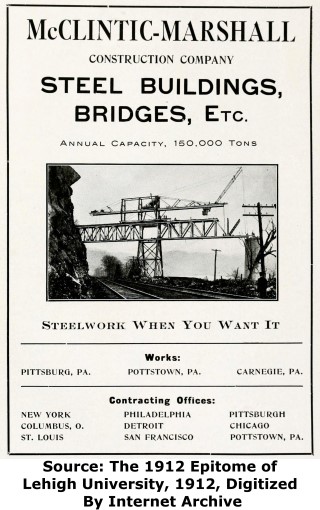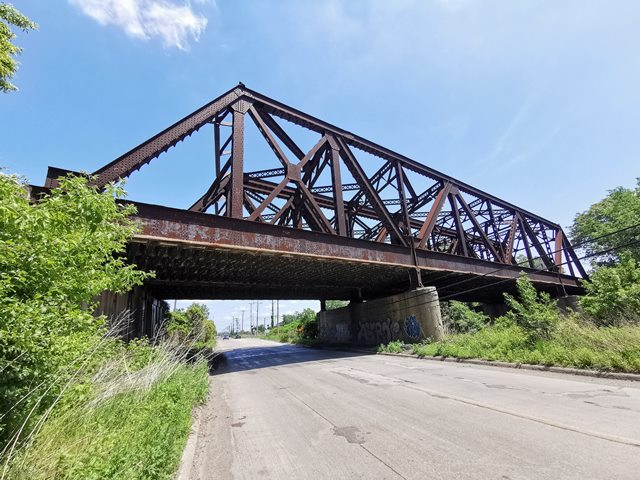We Recommend:
Bach Steel - Experts at historic truss bridge restoration.
BridgeHunter.com Phase 1 is released to the public! - Visit Now
Southern Avenue Railroad Truss Bridge

Primary Photographer(s): Nathan Holth and Rick McOmber
Bridge Documented: November 26, 2005, 2009, and May 29, 2022
Railroad (CSX) Over Southern Avenue and Railroad (Norfolk Southern)
Dearborn: Wayne County, Michigan: United States
1930 By Builder/Contractor: McClintic-Marshall Company of Pittsburgh, Pennsylvania
Not Available or Not Applicable
109.0 Feet (33.2 Meters)
233.0 Feet (71 Meters)
Not Available
3 Main Span(s)
Not Applicable

View Information About HSR Ratings
Bridge Documentation

This bridge ranks among the most unusual truss bridges around. First off, the bridge is a typically shaped trapezoidal truss, but in the unusual format of a continuous three span structure. A simple span bridge means that separate individual bridges connect the piers on a crossing. With a continuous span, the bridge has the appearance of a single span crossing, although there will be piers holding this span up in between abutments. Compare this to the CSX Bridge in Monroe, which is a simple three span structure. This bridge is a nine panel warren through truss, but at the west end of the bridge there is a highly unusual discrepancy in the truss configuration that makes this bridge asymmetrical. Note the two diagonals forming an 'X' at the right end in the above diagram, which "break" from the Warren truss configuration. Also note that the spacing of the piers between the abutments is not consistent. From east to west, there is a short span, long span, and medium span. The next unusual thing about this bridge is that it is really two bridge superstructures sitting right next to each other. Both bridges were built at the same time, and so each span is identical. They sit very close to each other. They both share the same substructure. Portal bracing is a large v-laced design Lattice is present on the rest of the bracing for this bridge. Lattice is also present on some diagonals and under the top chord, but the lattice is segmented by unusual angle sections. These angle sections give the bridge a rougher appearance. Another odd thing about this is the shear size of the bottom chord of this bridge. Usually the bottom chord is less massive than the top chord, but that is not the case here. Even the builder is unusual, at least here in Michigan. The plaque on the bridge credits the McClintic-Marshall Company of Pittsburgh, Pennsylvania with building the bridge in 1930. The company is mostly noted for building enormous bridges, this is a rare documented example of one of their smaller projects. Perhaps the only thing not unusual with this bridge is the substructure. It sits on concrete piers and abutments. The bearings on the bridge are weird however, as they are very tall.
This bridge is tagged with the following special condition(s): Unorganized Photos
![]()
Photo Galleries and Videos: Southern Avenue Railroad Truss Bridge
Bridge Photo-Documentation
Original / Full Size PhotosA collection of overview and detail photos. This gallery offers photos in the highest available resolution and file size in a touch-friendly popup viewer.
Alternatively, Browse Without Using Viewer
![]()
Bridge Photo-Documentation
Mobile Optimized PhotosA collection of overview and detail photos. This gallery features data-friendly, fast-loading photos in a touch-friendly popup viewer.
Alternatively, Browse Without Using Viewer
![]()
Additional Unorganized Photos
Original / Full Size PhotosA supplemental collection of photos that are from additional visit(s) to the bridge and have not been organized or captioned. This gallery offers photos in the highest available resolution and file size in a touch-friendly popup viewer.
Alternatively, Browse Without Using Viewer
![]()
Additional Unorganized Photos
Mobile Optimized PhotosA supplemental collection of photos that are from additional visit(s) to the bridge and have not been organized or captioned. This gallery features data-friendly, fast-loading photos in a touch-friendly popup viewer.
Alternatively, Browse Without Using Viewer
![]()
Maps and Links: Southern Avenue Railroad Truss Bridge
Coordinates (Latitude, Longitude):
Search For Additional Bridge Listings:
Bridgehunter.com: View listed bridges within 0.5 miles (0.8 kilometers) of this bridge.
Bridgehunter.com: View listed bridges within 10 miles (16 kilometers) of this bridge.
Additional Maps:
Google Streetview (If Available)
GeoHack (Additional Links and Coordinates)
Apple Maps (Via DuckDuckGo Search)
Apple Maps (Apple devices only)
Android: Open Location In Your Map or GPS App
Flickr Gallery (Find Nearby Photos)
Wikimedia Commons (Find Nearby Photos)
Directions Via Sygic For Android
Directions Via Sygic For iOS and Android Dolphin Browser
USGS National Map (United States Only)
Historical USGS Topo Maps (United States Only)
Historic Aerials (United States Only)
CalTopo Maps (United States Only)



